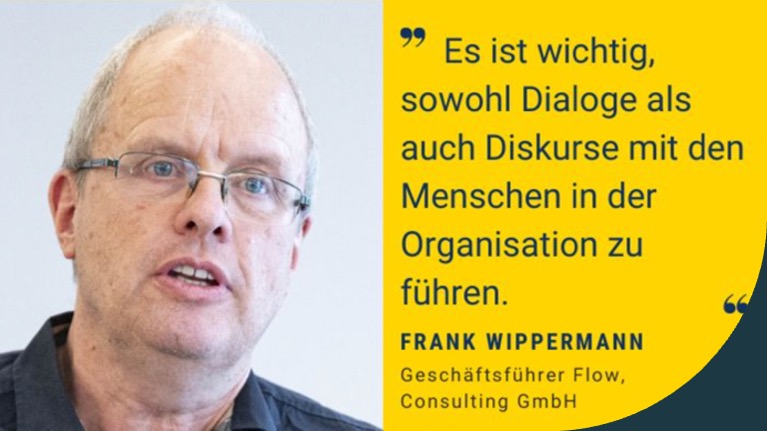Once a year, experts meet at the invitation of the German trade journal ‘Personalwirtschaft’ for the ‘Change Management’ round table. You can read about this year’s event here.
I’m at the table again this year. More precisely, the ‘Change Management’ round table. I always really appreciate taking part in this event. It’s a good opportunity to discuss important topics with experts from other consulting firms and to look beyond the horizon at current challenges.
Core topics: Leading change, skills shortage, AI
Thursday, early afternoon – we are online and this time there are six of us, one consultant, four advisors and one moderator. In the run-up to the event, we were asked about what we consider to be the most important topics relating to ‘change management’. And we are more unanimous than ever before:
- Leading change in uncertain times,
- shortage of skilled labour and the associated employer attractiveness,
- the role and function of AI.
There is also a consensus that these three topics are often cooked much hotter than they are eaten. In other words, many hypes that are individually hyped up in the media may attract attention. However, they are not only unhelpful for leadership and change – they are usually even harmful. Taken to the extreme: If, on the one hand, we are running out of people (demographics) and, on the other hand, AI is performing some tasks automatically – then these tendencies will initially balance each other out. At first … because, of course, the non-automated tasks will require different expertise, and therefore different training and further education.
Leading (complex) change
Dealing with uncertain situations not only needs to be learnt – leadership must also be able to withstand uncertainty. And for this very reason, and despite this, it is important to convey orientation to others. In addition, dealing confidently with uncertainty requires a manager to be able to reassure themselves: With their own employees, with their own superiors and also with external parties (such as customers, suppliers, authorities). Openness, a change of perspective and the ability to engage in dialogue support this reassurance. With the seven Future Skills for Leadership dynamic, we at flow consulting provided a good and reliable guide many years ago as to which skills are relevant for the leadership of tomorrow (and today).
On the organisational side, a high level of dynamism leads to a reduction or loss of importance of hierarchies, but never to their abandonment. Hierarchy is a feature of every organisation. How it is organised is a question of strategy and culture. What always remains are reliable structures and rules as a framework within which changes are managed. Adapting these structures and rules – key words: greater room for manoeuvre, more personal responsibility, shorter feedback loops – is one of the prominent management tasks in change management.
Shortage of skilled labour and employer attractiveness
Here, too, there is broad agreement in our group. Yes, good working conditions and meaningful work content make work and therefore the employer attractive. But what good are a foosball table and mobile working if the team atmosphere isn’t right and the manager is autocratic? Leadership as a good role model is still one of the best guarantees for high employee loyalty. In addition, professional onboarding processes, structured personnel development and work planning that gives equal consideration to employer and employee interests – keyword: flexibility compromise – are promising approaches to obtaining and retaining the rare commodity of ‘skilled labour’.
AI – artificial information processing
Word has probably got around that AI (such as Chat GPT and others) is not intelligent, but can merely analyse and combine existing information at breakneck speed. And managers and their HR departments should utilise this characteristic. What data is collected where and how can it be analysed in order to identify trends and tendencies? This requires a system of key figures that is both balanced (not just financial figures) and also reflects the interlinked effects of the processes based on key figures. The good old balanced scorecard, which has degenerated into a key figure graveyard in many companies, can – if used correctly – provide good services in combination with AI systems.
AI and change – it is immediately apparent that many companies have a few flagship projects. Linking AI-based technology with the expectations and skills of employees and organisational processes is often still in its infancy. In short: AI is not the solution to change management, but a (further) challenge: for the company, for the employees, for the management. Click here to access the flow tool digital maturity.
Summary
My conclusion from two hours of interesting dialogue with other experts: The questions in the organisations and the questions in the consulting companies are similar. What we, the consulting companies, can do well is to take a problem-oriented external view with ideas from a broad repertoire of tools and solutions. These solutions are not all-rounders. Rather, they are impulses that must and can be adapted to the organisation-specific challenges and opportunities. And this also requires an external perspective, for example and preferably that of flow consulting.
Click here to read the German article in the trade journal ‘Personalwirtschaft’: https://www.personalwirtschaft.de/events/roundtables/change-management-wie-bewaeltigt-hr-multiple-herausforderungen-171008/



